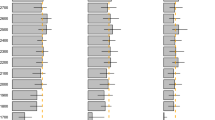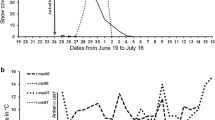Abstract
Global climate change is regarded as one of the major threats to biodiversity. Both local and regional climate parameters can have strong effects on ecological processes affecting the survival and reproduction of plants and animals. High Arctic ecosystems are characterized by low species diversity and the local species have often evolved specific adaptations to the harsh Arctic environment. Here, we investigate the effect of local and regional climate parameters on snow bunting (Plectrophenax nivalis) reproductive success in the Arctic using a long-term dataset of 15 years. We found strong relationships between both local weather and the Arctic oscillation (AO), a regional climate index, with several breeding parameters. Onset of breeding was earlier in years with high spring temperatures and later in years with high AO index the preceding winter. Importantly, high AO winter index also increased the number of successful fledglings the following summer, possibly mediated via spring phenology. Nestling weight was negatively associated with the AO index during the breeding season. The strong effects of local and regional climate suggest that the ongoing global climate change could potentially have a large effect on this Arctic passerine population.






Similar content being viewed by others
References
Aanes R, Sæther BE, Smith FM, Cooper EJ, Wookey PA, Oritsland NA (2002) The Arctic oscillation predicts effects of climate change in two trophic levels in a high-arctic ecosystem. Ecol Lett 5:445–453
Ackerman JT, Eagles-Smith CA (2010) Accuracy of egg flotation throughout incubation to determine embryo age and incubation day in waterbird nests. Condor 112:438–446
Baayen R (2011) languageR: data sets and functions with “analyzing linguistic data: a practical introduction to statistics”. R package version 1.4
Bangjord G, Pedersen Å, Djøseland O (1999) Hekkende snøspurv i fuglekasser på Svalbard. Vår Fuglefauna 22:109–111
Bates D, Maechler M, Bolker B (2012) lme4: linear mixed-effects models using S4 classes. R package version 0.999999-0
Both C, Van Turnhout CAM, Bijlsma RG, Siepel H, Van Strien AJ, Foppen RPB (2010) Avian population consequences of climate change are most severe for long-distance migrants in seasonal habitats. Proc R Soc B 277:1259–1266
Carey C (2009) The impacts of climate change on the annual cycles of birds. Philos Trans R Soc B 364:3321–3330
Cramp S, Perrins C (1994) Buntings and new world warblers. The birds of the Western Palearctic, vol IX. Oxford University Press, Oxford
Dawson RD, Lawrie CC, O’Brien EL (2005) The importance of microclimate variation in determining size, growth and survival of avian offspring: experimental evidence from a cavity nesting passerine. Oecologia 144:499–507
Førland EJ, Benestad R, Hanssen-Bauer I, Haugen JE, Skaugen TE (2011) Temperature and precipitation development at Svalbard 1900–2100. Adv Meterol (Article ID 893790)
Forsman JT, Mönkkönen M (2003) The role of climate in limiting European resident bird populations. J Biogeogr 30:55–70
Gwinner E (1996) Circadian and circannual programmes in avian migration. J Exp Biol 199:39–48
Hallett TB, Coulson T, Pilkington JG, Clutton-Brock TH, Pemberton JM, Grenfell BT (2004) Why large-scale climate indices seem to predict ecological processes better than local weather. Nature 430:71–75
Hanssen-Bauer I, Forland EJ (1998) Long-term trends in precipitation and temperature in the Norwegian Arctic: can they be explained by changes in atmospheric circulation patterns? Clim Res 10:143–153
Hoset KS, Espmark Y, Moksnes A, Haugan T, Ingebrigtsen M, Lier M (2004) Effect of ambient temperature on food provisioning and reproductive success in snow buntings Plectrophenax nivalis in the high Arctic. Ardea 92:239–246
Hoset KS, Espmark Y, Lier M, Haugan T, Wedege MI, Moksnes A (2009) The effects of male mating behaviour and food provisioning on breeding success in snow buntings Plectrophenax nivalis in the high Arctic. Polar Biol 32:1649–1656
Hoset KS, Espmark Y, Fossøy F, Stokke BG, Jensen H, Wedege MI, Moksnes A (2014) Extra-pair paternity in relation to regional and local climate in an Arctic breeding passerine. Polar Biol 37:89–97
Hurrell JW (1995) Decadal trends in the North-Atlantic oscillation—regional temperatures and precipitation. Science 269:676–679
Hussell DJT (1985) On the adaptive basis for hatching asynchrony—brood reduction, nest failure and asynchronous hatching in snow buntings. Ornis Scand 16:205–212
Mac Nally R (2000) Regression and model-building in conservation biology, biogeography and ecology: the distinction between and reconciliation of ‘predictive’ and ‘explanatory’ models. Biodivers Conserv 9:655–671
McCarty JP, Winkler DW (1999) Relative importance of environmental variables in determining the growth of nestling tree swallows Tachycineta bicolor. Ibis 141:286–296
Møller A, Fiedler W, Berthold P (eds) (2010) Effects of climate change on birds. Oxford University Press, New York
Pauls SU, Nowak C, Bálint M, Pfenninger M (2013) The impact of global climate change on genetic diversity within populations and species. Mol Ecol 22:925–946
Pettorelli N (2012) Climate change as a main driver of ecological research. J Appl Ecol 49:542–545
Post E et al (2009) Ecological dynamics across the Arctic associated with recent climate change. Science 325:1355–1358
R Development Core Team (2012) R: a language and environment for statistical computing. R Foundation for Statistical Computing, Vienna
Schaper SV, Dawson A, Sharp PJ, Gienapp P, Caro SP, Visser ME (2012) Increasing temperature, not mean temperature, is a cue for avian timing of reproduction. Am Nat 179:E55–E69
Serreze MC, Barry RG (2011) Processes and impacts of Arctic amplification: a research synthesis. Glob Planet Change 77:85–96
Skjøstad MB (2008) Sammenhengen mellom næringstilgang og reproduktiv suksess hos snøspurv (Plectrophenax nivalis). Master thesis, Norwegian University of Science and Technology
Starck JM (1998) Avian growth and development: evolution within the altrical precocial spectrum. Oxford ornithology series. Oxford University Press, New York
Stenseth NC, Mysterud A (2005) Weather packages: finding the right scale and composition of climate in ecology. J Anim Ecol 74:1195–1198
Thompson DWJ, Wallace JM (1998) The Arctic Oscillation signature in the wintertime geopotential height and temperature fields. Geophys Res Lett 25:1297–1300
Thompson DWJ, Wallace JM, Hegerl GC (2000) Annular modes in the extratropical circulation. Part II: trends. J Climate 13:1018–1036
Urban MC, De Meester L, Vellend M, Stoks R, Vanoverbeke J (2012) A crucial step toward realism: responses to climate change from an evolving metacommunity perspective. Evol Appl 5:154–167
Visser ME, Both C (2005) Review. Shifts in phenology due to global climate change: the need for a yardstick. Proc R Soc B 272:2561–2569
Visser ME, te Marvelde L, Lof ME (2012) Adaptive phenological mismatches of birds and their food in a warming world. J Ornithol 153:S75–S84
Walsh C, Mac Nally R (2008) hier.part: hierarchical partitioning. R package version 1.0-3
Walther G-R et al (2002) Ecological responses to recent climate change. Nature 416:389–395
Acknowledgments
This study was funded by The Royal Norwegian Society of Sciences and Letters (grant to Y.E.), the Norwegian Research Council (student grants) and the Norwegian University of Science and Technology, NTNU. We would like to thank Jo Anders Auran, Roger Dahl, Gunn Frilund, Tommy Haugan, Eva Hofstad, Steffen Håkonsen, John Ivar Iversen, Tore K.S. Leren, Marie Lier, Mari Murtomaa, Ida A.C. Nävås, Per H. Olsen, Mari Berger Skjøstad and Tom Roger Østerås for valuable help during the fieldwork, and Ivar Herfindal for advice on statistical methods.
Author information
Authors and Affiliations
Corresponding author
Rights and permissions
About this article
Cite this article
Fossøy, F., Stokke, B.G., Kåsi, T.K. et al. Reproductive success is strongly related to local and regional climate in the Arctic snow bunting (Plectrophenax nivalis). Polar Biol 38, 393–400 (2015). https://doi.org/10.1007/s00300-014-1595-6
Received:
Revised:
Accepted:
Published:
Issue Date:
DOI: https://doi.org/10.1007/s00300-014-1595-6




